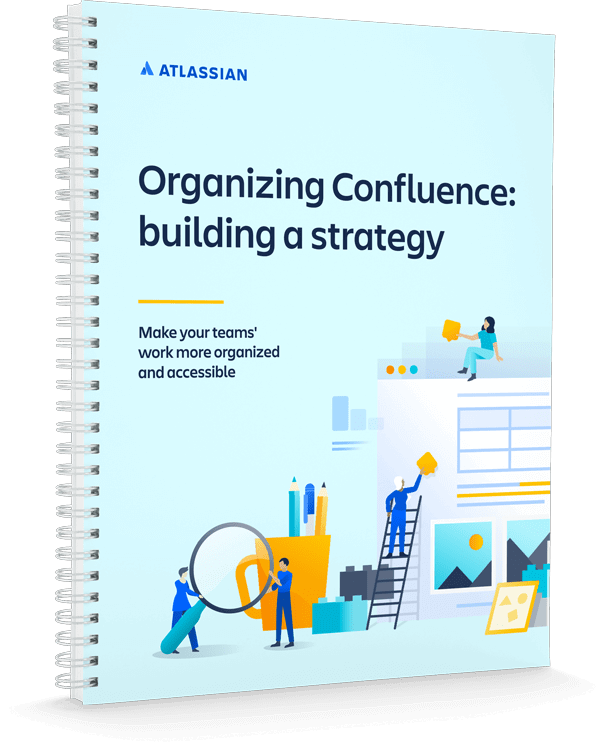Organizing Confluence: building a strategy
Organized and accessible information helps teams accomplish more together. Read on for tips or download a handy reference PDF.
Introduction
What is information architecture?
Information architecture is the practice of organizing knowledge. Like building architecture, it involves designing and constructing an effective structure. For companies creating an information architecture strategy allows users to better manage and find information.
Who needs an information architecture strategy?
In short, everyone! Keeping knowledge organized and accessible helps organizations accomplish more together. Without an information architecture strategy, knowledge can easily become disorganized, hard to use and outdated.
If your organization is already using Confluence, the way you organize (or don’t organize!) pages or spaces may be working for now. But as usage grows, having an information architecture strategy makes it easier for teams to collaborate.
GET STARTED
How to create an information architecture strategy for Confluence
The steps required to create an information architecture strategy for Confluence are very similar to the steps required to create a new building or home. We’ve broken down the process below:
Step one
Perform a site analysis
Before breaking ground on construction, architects will tour a site to understand the land or structure they’ll be working with. During this time, they’ll make note of the site’s surroundings and details to consider in their design.
Similarly, you'll want to perform an analysis on your Confluence instance. Depending on the size and complexity of your Confluence instance, this analysis could be quick or take your team a bit of time.
Are information architecture and enterprise content management the same?
Information architecture and enterprise content management are often used interchangeably, but the terms refer to different concepts.
Enterprise content management
Enterprise content management (ECM) solutions help digitally manage an organization’s knowledge and information in order to support its business goals. The right ECM solution will help automate processes, increase productivity, and encourage teams across a business to work better together.
Information architecture
Having an information architecture strategy is an important part of successfully implementing an enterprise content management solution. An effective information architecture strategy will ensure that knowledge is organized and accessible for an organization’s users and teams.
Step 2
Design your floor plan
Next, an architect will think about the building occupants' needs and design a floor plan suited for these needs. Similarly, once you have an understanding of your Confluence instance and organization’s needs, you can build a plan for organizing information.
After speaking to many customers, we’ve learned that there are generally five levels of content in any Confluence instance:
| Confluence content levels |
|---|
| Organization or company-level content |
| Department-level content |
| Team-level content |
| Project-level content |
| Personal content |
Sound familiar? Your organization may have all of these types of content, or you may only have a few. We suggest taking the framework above and applying it to the information in your Confluence instance in order to design your organization’s ideal “floor plan” or structure.
Once you’ve come up with a basic structure for information, you’ll want to socialize your plan with key stakeholders and get their buy-in before implementing any changes.
Already seeing your team’s usage of Confluence grow?
Confluence Data Center is our self-managed enterprise edition of Confluence, built to support your organization’s long-term size, complexity, and governance needs.

Organizing Confluence: building a strategy
Download a PDF guide for more detailed tips on organizing Confluence that you can reference offline or easily share.
Step three
Constructing your building
After a floor plan has been finalized, an architect will hand off execution and construction to a builder. The builder will follow the floor plan’s specifications to finish the building.
Likewise, in Confluence, you will want to enlist your team or stakeholders to help you execute on your plan. For some, this means handing off execution to a centralized IT team. For others, this means the team administering Confluence provides a template. Whichever option you choose, make sure to align on a timeline for delivery and touch points to check in on progress.
Step four
Moving in
When building is completed, the architect and builder will hand over the keys to the occupants so they can move in! In the same way, once your Confluence instance has been organized you can allow your users to move in.
If you had existing information in Confluence, this means your teams will spend time moving their pages. This is an important step in getting your existing information organized, so the information your teams create in Confluence in the future has a place to live.
Pro tip
Once you’ve moved pages to the right spaces, if you need to retroactively apply labels to pages there are plenty of Atlassian Marketplace apps and macros that can help you do this quickly and effectively in bulk!
Step five
Decorating and ongoing maintenance
Once occupants have moved, it’s up to them to decorate and maintain it. Preventative maintenance helps keep a building in top shape. In Confluence, you and your organization will want to maintain your information architecture strategy by following some of these best practices:
- Put out the welcome mat with a structured onboarding
- Clean on a regular basis
- Tend to your spaces by assigning a ‘gardener’
- Label important items
- Decorate your space home pages
- Add functionality with macros
- Save time with templates
Get the detailed list of best practices in the PDF
Additional resources

Confluence Data Center Guide for Success

Five pro-tips to get the most out of Confluence Webinar

Secrets to Streamlining your Collaboration Tools Webinar

Tips for Organizing Spaces